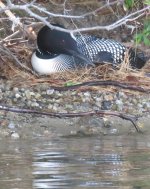No Title
Mike efficient paddling is mindless paddling. After you have some techniques down and practice for a while, there is no need to think about physics. Just do.
I have to say that I feel I need to defend the usefulness of lessons. Prior I was always cramped up and tight and not loose. Worried about tipping.. Exhausted after 15 km solo( now 40 is not usually a big deal unless there are lots of ports and wind..wind)
I teach the ACA techniques for a reason. Not to be canoe police.. For the reason I like to finish up an outing with others with everyone smiling.. I cannot count how many people I have helped out of J stroke cramp hell, or plain exhaustion, or to help them feel secure in any condition in a boat.
It seems there are those who box up components into spiritual moment box and scientific box.. The boxes are not separate. They nest.
There are those self taught that do well and others that throw away the canoe paddle entirely because "its too hard". It need not be.
I know the hallmark of canoe physics is FreeStyle. Well it lets me paddle in circles for miles each day.. feel the air....feel my body stretch and relax. and it has the side effect of not scaring wildlife. on trips I make the most out of each paddle stroke to conserve energy. I have yet to meet a FS canoer that was not a tripper at heart. I have met many canoe trippers with closed minds, who have not even tried anything new and are determined never to in the future either. I love the opportunity to always discover a new way of paddling that can make it easier and prolong my paddling life.
Meet my loon. I was practicing. You really think I was analyzing stroke angle? LOL!!
A few years ago at an instructors update on FreeStyle we were reminded that the most efficient way to go up wind was hit and switch.. So one of our tests was to use that technique on rockered boats and keep a straight line. We learned cab forward did mean less work and not having to correct was less work.. Having eschewed light bent shaft paddles before that I now love mine. And that Zaveral has proved to be a real energy saver in my Monarch in the Everglades. Ask Joe Wildlife.. Hit and switch is the most efficient in a wicked Florida Bay headwind.
Less and less am I using my double but there is an efficient way to use those too. Or use them badly and waste energy.
True your trip is not my trip but all trips should be the least work as possible
Mike efficient paddling is mindless paddling. After you have some techniques down and practice for a while, there is no need to think about physics. Just do.
I have to say that I feel I need to defend the usefulness of lessons. Prior I was always cramped up and tight and not loose. Worried about tipping.. Exhausted after 15 km solo( now 40 is not usually a big deal unless there are lots of ports and wind..wind)
I teach the ACA techniques for a reason. Not to be canoe police.. For the reason I like to finish up an outing with others with everyone smiling.. I cannot count how many people I have helped out of J stroke cramp hell, or plain exhaustion, or to help them feel secure in any condition in a boat.
It seems there are those who box up components into spiritual moment box and scientific box.. The boxes are not separate. They nest.
There are those self taught that do well and others that throw away the canoe paddle entirely because "its too hard". It need not be.
I know the hallmark of canoe physics is FreeStyle. Well it lets me paddle in circles for miles each day.. feel the air....feel my body stretch and relax. and it has the side effect of not scaring wildlife. on trips I make the most out of each paddle stroke to conserve energy. I have yet to meet a FS canoer that was not a tripper at heart. I have met many canoe trippers with closed minds, who have not even tried anything new and are determined never to in the future either. I love the opportunity to always discover a new way of paddling that can make it easier and prolong my paddling life.
Meet my loon. I was practicing. You really think I was analyzing stroke angle? LOL!!
A few years ago at an instructors update on FreeStyle we were reminded that the most efficient way to go up wind was hit and switch.. So one of our tests was to use that technique on rockered boats and keep a straight line. We learned cab forward did mean less work and not having to correct was less work.. Having eschewed light bent shaft paddles before that I now love mine. And that Zaveral has proved to be a real energy saver in my Monarch in the Everglades. Ask Joe Wildlife.. Hit and switch is the most efficient in a wicked Florida Bay headwind.
Less and less am I using my double but there is an efficient way to use those too. Or use them badly and waste energy.
True your trip is not my trip but all trips should be the least work as possible
Attachments
Last edited:

